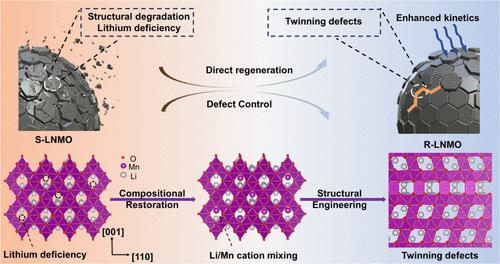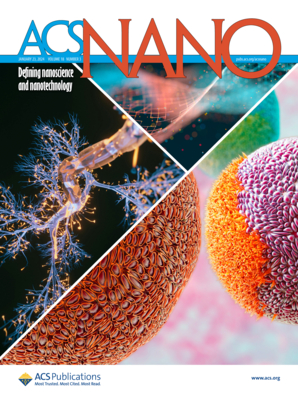了解和控制用于直接循环的 LiNi0.5Mn1.5O4 阴极中的结构缺陷和失序现象
IF 15.8
1区 材料科学
Q1 CHEMISTRY, MULTIDISCIPLINARY
引用次数: 0
摘要
尽管在回收废旧锂离子电池 (LIB) 方面取得了重大进展,但无损直接回收方法在多种正极化学性质方面仍存在难以维持的差异,这主要源于回收过程中的各种结构稳定性。通过系统研究再回火处理过程中的微观结构演变,我们观察到 LiNi0.5Mn1.5O4 阴极中不可避免地诱发了缺陷和 Li/Mn 紊乱,导致 Li+ 传输迟缓和不可逆容量损失。我们采用缺陷工程方法实现了孪晶边界和优选晶粒取向,结果表明再生阴极大大提高了 Li+ 扩散和循环稳定性,在 C/3 下循环 100 次后容量保持率为 97.4%,循环 200 次后容量保持率为 87.96%。这项工作不仅详细阐述了缺陷诱导和结构恢复机制的系统研究,而且提供了直接回收高压尖晶石型阴极的有效方法,有助于下一代 LIB 的可持续发展。本文章由计算机程序翻译,如有差异,请以英文原文为准。

Understanding and Controlling Structural Defects and Disordering in LiNi0.5Mn1.5O4 Cathodes for Direct Recycling
Despite significant progress in recycling spent lithium-ion batteries (LIBs), nondestructive, direct recycling methods still face untenable discrepancies in multiple cathode chemistries, which primarily originate from a variety of structure stabilities during the recycling process. Through systematic investigation of the microstructure evolution during the relithiation treatment, we observed the inevitably induced defects and Li/Mn disordering in the LiNi0.5Mn1.5O4 cathode, contributing to the sluggish Li+ transport and irreversible capacity loss. Employing a defect engineering approach to achieve twin boundaries and preferred grain orientation, we show the regenerated cathodes demonstrate a substantial enhancement of Li+ diffusion and cycling stability, retaining 97.4% capacity after 100 cycles and 87.96% after 200 cycles at C/3. This work not only elaborates on a systematic investigation of defect inducement and structural restoration mechanism but also provides an effective approach to directly recycle high-voltage spinel-type cathodes, contributing to the sustainability of next-generation LIBs.
求助全文
通过发布文献求助,成功后即可免费获取论文全文。
去求助
来源期刊

ACS Nano
工程技术-材料科学:综合
CiteScore
26.00
自引率
4.10%
发文量
1627
审稿时长
1.7 months
期刊介绍:
ACS Nano, published monthly, serves as an international forum for comprehensive articles on nanoscience and nanotechnology research at the intersections of chemistry, biology, materials science, physics, and engineering. The journal fosters communication among scientists in these communities, facilitating collaboration, new research opportunities, and advancements through discoveries. ACS Nano covers synthesis, assembly, characterization, theory, and simulation of nanostructures, nanobiotechnology, nanofabrication, methods and tools for nanoscience and nanotechnology, and self- and directed-assembly. Alongside original research articles, it offers thorough reviews, perspectives on cutting-edge research, and discussions envisioning the future of nanoscience and nanotechnology.
 求助内容:
求助内容: 应助结果提醒方式:
应助结果提醒方式:


